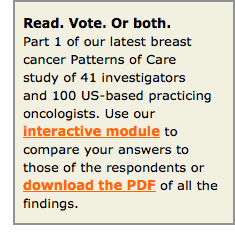Editor's Note
Patterns of Care in Breast Cancer — Interactive Edition: Adjuvant chemotherapy for ER-positive, HER2-negative tumors
Kathy — who sees several second opinion cases a week in clinic and responds to many more by email and phone — did not hesitate in answering, “It comes up a lot in the use of adjuvant chemotherapy, particularly in patients with ER-positive, HER2-negative, node-negative tumors over 2 centimeters or patients with limited nodal involvement.” She then went on to describe a recent case in which an IU colleague ordered an Oncotype DX® for a 43-year-old woman with 1 positive node referred by her surgeon, who was surprised when an initial consulting oncologist did not order the assay. On the day before the patient was scheduled to start adjuvant chemo with the first oncologist, the Recurrence Score® (RS) came back as 6 (low), leading the IU team to recommend endocrine therapy alone. The patient embraced the concept and cancelled the chemo appointment, creating some uncomfortable feelings among the parties involved. This got me thinking about our post-SABCS Think Tank last month, during which Dr Miller, in voicing her “biology over anatomy” perspective, drew considerable objection from Dr Dan Hayes, who had recently published a JCO editorial concluding that the use of Oncotype in a patient with a node-positive tumor should be reserved for participants in the ongoing RxPONDER trial evaluating endocrine treatment alone or preceded by chemo in patients with 1 to 3 positive nodes and low RS. Providing a window into these types of controversies is essential to our group’s CME mission, and an important tool in this regard has been our national Patterns of Care surveys of investigators and practicing oncologists. This email (the first of 3) marks the introduction of our latest breast cancer survey that is presented this time not in hard copy as in prior adventures but as an interactive web-based practicum. We begin with the core of the Miller/Hayes controversy — adjuvant chemo in ER-positive, HER2-negative tumors — and, for those of you who don’t have time to pore through all the related questions/results (they are very interesting) or aren’t inclined to try out our new format and vote, below is the “10,000-foot view” of how the use of Oncotype impacts decision-making in clinics across the country. 1. Node-negative tumors The story is a bit different with a 3-cm tumor, for which 90% of investigators use Oncotype compared to 68% of community oncologists. Here, the nonusers are likely already committed to chemo, but 34% would hold off if someone else ordered the assay and it came back low. 2. Node-positive tumors 3. Is 75 the new 60? Next, for Part 2 of this interactive Patterns of Care activity/report, we present data on another rapidly evolving corner of breast oncology — patients with early and advanced HER2-positive disease. Neil Love, MD |


